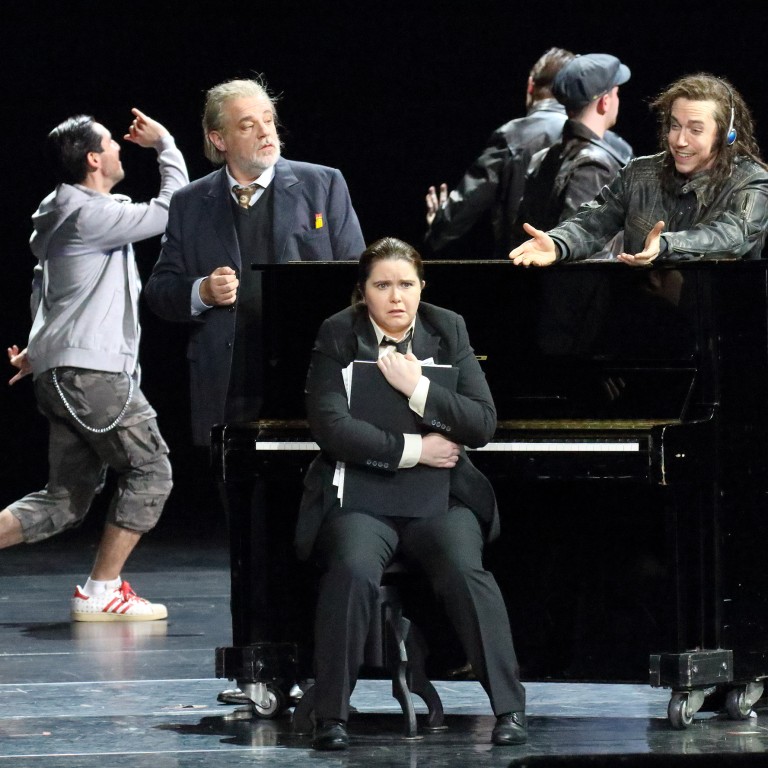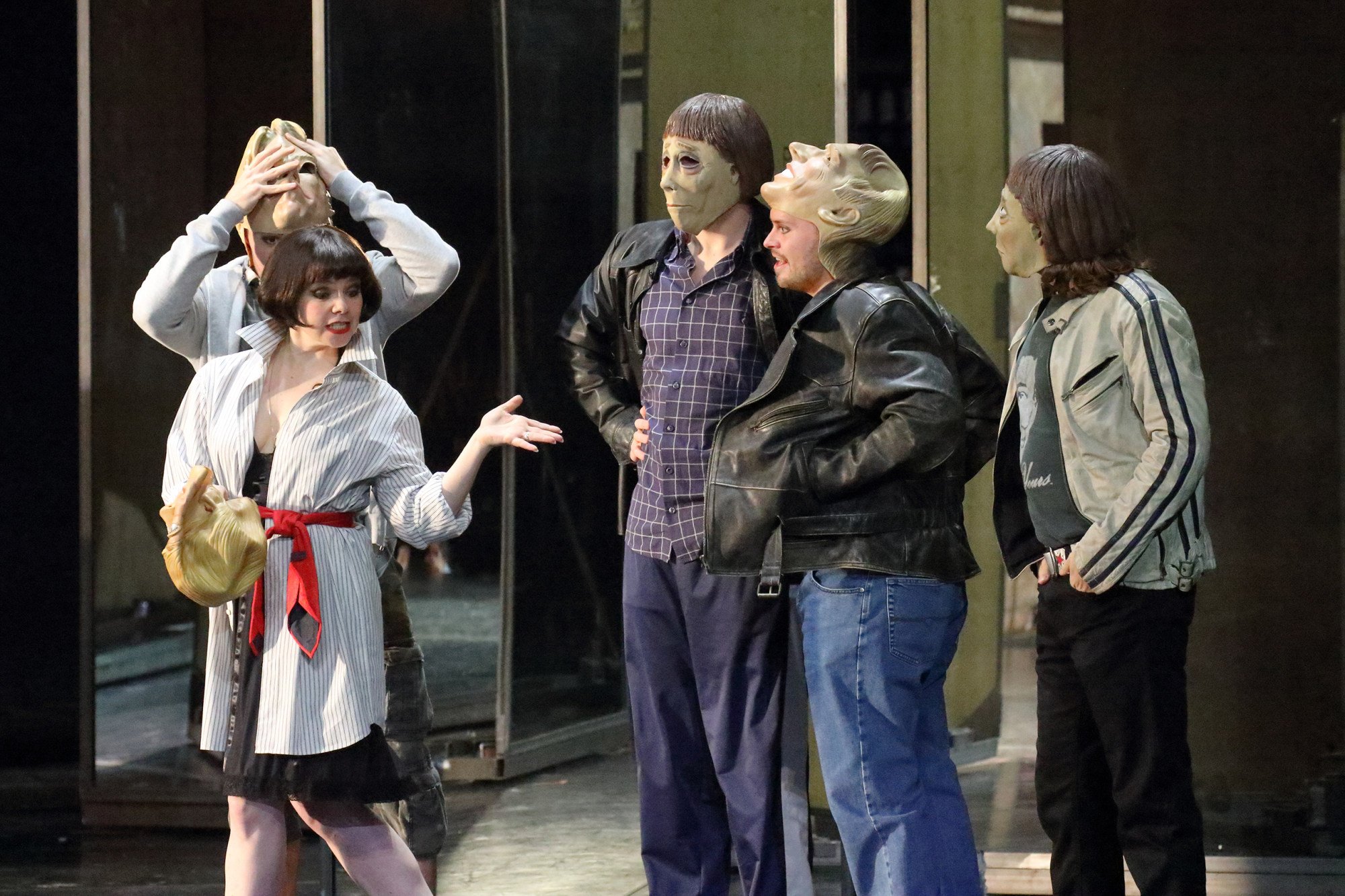
Review | Ariadne auf Naxos: Hong Kong Arts Festival opener is an opera within an opera that treats the ears better than the eyes
- Ariadne auf Naxos pits highbrow opera against lowbrow comedy, and the commedia dell’arte wins hands down with vocal pyrotechnics
- In the opera section, the cast and scenery are all in black, but the powerful singing and impressive playing from the orchestra make this a winner
Ariadne auf Naxos is a bold choice to open this year’s Hong Kong Arts Festival.
An opera that can be a challenge for audiences more used to Verdi or Puccini, it’s a tricky work – top-notch performances and a lot of imagination in terms of direction and design are needed to pull it off.
This production by Bayerische Staatsoper was more a feast for the ears than for the eyes – it scored strongly on musical excellence, but the 2008 staging by Robert Carsen looked dated.
The opera was conceived by Richard Strauss and his librettist, Hugo von Hofmannsthal, in 1912 as a musical divertissement to accompany the latter’s adaptation of Molière’s Le Bourgeois Gentilhomme.

This unwieldy format was not a success, and in 1916 a revised version was created that proved more popular and was the one shown here.
It is an opera within an opera, and opens with a prologue where we learn that Vienna’s richest man is hosting a party. To entertain his guests after dinner, he has commissioned a short opera, Ariadne auf Naxos, to be followed by a performance from a commedia dell’arte troupe before the evening ends with a firework display.
‘Do you get aroused?’ A retired dancer aims to demystify ballet
The opera’s young composer is outraged that low comedy will feature in the same evening as his masterpiece – his diva and tenor are equally insulted, while the comedians, led by the vivacious Zerbinetta, are sure that they will upstage the “boring” opera.
Things go from bad to worse when the host decides that, since the fireworks have to start at 9pm, there won’t be enough time for separate shows, so the two groups must create a combined performance.
The opera proper then begins. Ariadne has been abandoned on the island of Naxos by her beloved Theseus, despite saving his life. Attended by a chorus of three nymphs, she sings of her sorrow and how she longs for death.
Zerbinetta and her troupe appear and try to cheer Ariadne up. Zerbinetta explains her own approach to love: while all women suffer heartbreak, it doesn’t have to last and there’s always another lover – “another new god” – on the horizon. Ariadne, however, refuses to listen and remains trapped in despair.

Fleeing from the enchantress Circe, the god Bacchus arrives on the island. He thinks that Ariadne is another sorceress, while Ariadne thinks he is Hermes, the messenger of death, come to take her to the underworld. Eventually realising their true identities, the pair fall in love and the piece ends with them finding happiness together.
The opera’s main theme is the conflict between highbrow and lowbrow art. Ariadne and Zerbinetta are contrasted in musical styles as well as character, one being a dark-toned dramatic soprano, the other a sparkling coloratura.
Whatever Strauss and von Hofmannsthal’s intentions may have been, the lowbrow sections win hands down. The music for the comic troupe is irresistibly rollicking and Zerbinetta’s vocal pyrotechnics dazzling, whereas Ariadne’s monotonously mournful arias soon pall.
Best of the “serious” music are the lyrical trio for the nymphs when Bacchus arrives and the uplifting finale for Bacchus and Ariadne.

Carsen’s production features some good moments alongside some strange choices, notably having no intermission (there’s usually one after the prologue), which may have contributed to a number of people leaving during the performance, although those who stayed gave it an enthusiastic reception at the end.
The prologue is well done, moving along at a brisk pace and bringing out the humour neatly.
The desert island where Ariadne was abandoned doesn’t sound like an entertaining backdrop, something which was pointed out to the wealthy host. Most productions seek to overcome with eye-catching, colourful designs. Carsen and his team (Peter Pabst, sets and Felk Bauer, costumes) have taken the opposite approach and adopted a colour scheme consisting solely of black.
‘It helped to shape me’: Hong Kong Arts Festival director’s eye-opening read
The piece is performed against a backdrop of plain black curtains and the entire cast (including Zerbinetta’s male companions) wear identical black dresses and long wigs, while Bacchus enters clad in what can only be described as a black silk dressing gown.
Eventually the comic troupe do add a few coloured garments, including a pair of red high heels for Zerbinetta, but visually, black on black is just plain dull.
A group of 16 dancers is employed to populate what would otherwise be a largely empty stage, but they have little to do other than stand behind the singers and mimic their gestures.

The moment where the black curtains finally draw back to let in light as Ariadne and Bacchus find happiness works well and the ending with the Composer alone on the stage is touching.
By far the best sequence is the one where the men vie for Zerbinetta’s favour with some Chippendales-style fun.
Conductor Patrick Lange and the Bayerisches Staatsorchester did an outstanding job in the pit, drawing out the nuances of the score to great effect. On stage the show was stolen by Brenda Rae’s star turn as Zerbinetta, vividly acted and sung with breathtaking virtuosity.
There was powerful dramatic singing from Rachel Willis-Sorensen as Ariadne and Clay Hilley as Bacchus.
Tara Erraught’s exquisitely sung and touchingly acted Composer was a delight, and kudos to Zerbinetta’s suitors (Sean Michael Plumb, Joel Williams, Daniel Noyola and Liam Bonthrone) for singing so well while gallantly performing antics not usually expected of opera singers.
Hong Kong Arts Festival: Ariadne Auf Naxos, Bayerische Staatsoper, Hong Kong Cultural Centre Grand Theatre. Reviewed: February 22

